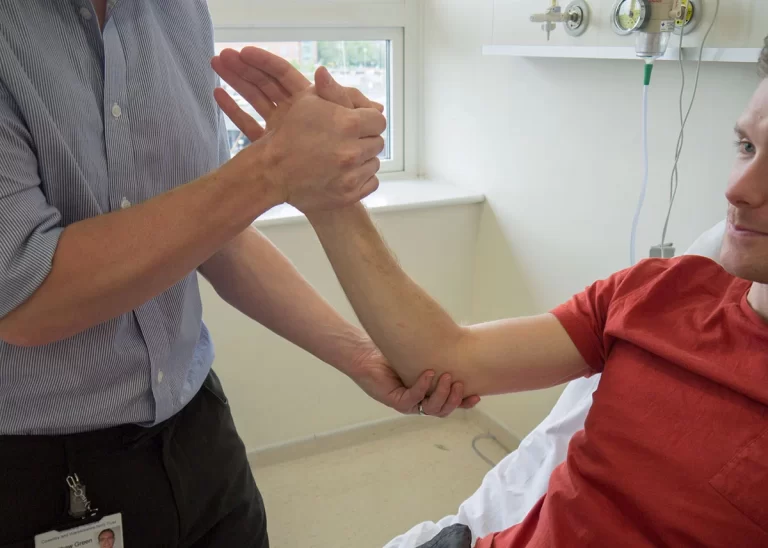Cervical Flexion-Rotation Test = CFRT:
- The Cervical Flexion-Rotation Test = CFRT in contrast to other forms of the manual examination.
- It is an easily applied clinical test for purportedly biased to assess the dysfunction at the motion segment of C1-C2.
- The C1-C2 cervical spine motion segment is accounted for 50% of the rotation in the cervical spine.
- Manual examination of this test sensitivity = high & specificity which is detect to the presence /absence of cervical joint dysfunction for the neck pain & headache patients.
- So that these tests are involved a high degree of skill on the part of the examiner & reliability of this is questioned.
- In this Cervical Flexion-Rotation Test procedure, so that the cervical spine is fully flexed, into the attempt to isolate the movement of to the C1-C2 of the cervical spine, which is unique for the ability to rotate in the flexion movement. The normal range of rotation motion = ROM in the end range of flexion movement is shown to be 44° to each side. In the contrast, the subjects are suffering from headaches with the C1-C2 of cervical spine dysfunction for an average of 17° in less rotation.
- Smith et al.
- It is concluded that age does not significantly influence the mobility during the CFRT = Cervical Flexion-Rotation Test One explanation for this test is could be that the upper cervical spine is undergoing minimal age-related degenerative changes & in comparison to the joints which is lower in the cervical spine.
- Also, many lifestyle factors are including that time spent sitting, sleep position, & side dominant lifestyle which does not appear to influence variability in cervical mobility.
What is the purpose of the Cervical Flexion-Rotation Test = CFRT?
- The patient is in the supine lying position.
- The examiner [ therapist] sits or stands at the head of the patient & flexes the cervical spine fully.
- While holding the flexed position, the examiner [ therapist ] then rotates the head left & right.
- Normal rotation in the flexed position should be about 45′ each way.
- Maintaining the flexed position is more likely to isolate the rotation to the C1 -C2 area so that C1 -C2 area so that C1 -C2 dysfunction may be evident if the rotation is less [ hypo-mobility ] or more [ hyper-mobility ] than normal.
What is Evidence of the Cervical Flexion-Rotation Test = CFRT?

- Hall et al.
- It is shown that sensitivity, diagnostic accuracy & specificity of the CFRT = Cervical Flexion-Rotation Test is very high 90% & 88% with the 92% agreement for the experienced examiners P<.001.
- Furthermore, although the inexperienced examiners reported a greater range for the CFRT = Cervical Flexion-Rotation Test than the experienced examiners, sensitivity, specificity & agreement is still within the clinically acceptable levels.
- The CFRT= Cervical Flexion-Rotation Test is a useful clinical measure in cervical movement impairment & it assists in the differential diagnosis of Cervicogenic Headache.
- Good levels of inter & intra-observer reliability are established by Takasaki et al.
- Comparing the manual test outcome with the MRI measurement of cervical segment rotation.
- ICCs is greater than 0.7 with the narrow 95% confidence interval values for a mean range of rotation = ROM.
- These data lend support to the content validity of the CFRT = Cervical Flexion-Rotation Test as a clinical test of atlanto-axial mobility.
- It is important to recognize that the CFRT = Cervical Flexion-Rotation Test.
- It is a relatively isolated test of the movement impairment of the C1-C2 motion segment & may not adequately test the other motion segments.
Differential Diagnosis of the Cervical Flexion-Rotation Test = CFRT:
- Recently, it is shown that the impairment of cervical movement, in association with the palpable upper cervical joint dysfunction & impairment in the craniocervical muscle control
- in the sensitivity of = 100% & the specificity of = 94% to identify Cervicogenic Headache from the Migraine.
- This is clinically important since for example physiotherapy is found to be effective for Cervicogenic Headache CGH but not for migraine.
- The range is most restricted in the subjects with the CGH = 25° significantly more important impairment than either group’s Migraine (42′ or Multiple Headache forms to MHF = 35°.
- It appears that the presence of the aura is a minimal effect on the range of motion during the CFRT= Cervical Flexion-Rotation Test.
- As stated previously, the CFRT = Cervical Flexion-Rotation Test is been shown negative in the subjects with the CGH where the pain arises from the cervical levels other than C1-C2 of the cervical spine.
Pettman’s distraction test:
- This test is used to test the tectorial membrane.
- The patient lies with the head in a neutral position.
- The examiner [ therapist ] applies gentle traction to the head.
- Provided no symptoms are produced, the patient’s head is lifted forward, flexing the spine & traction is reapplied.
- If the patient complains of symptoms, like pain or paresthesia in the second position, then the test is considered positive for a laxtectorial membrane.








One Comment